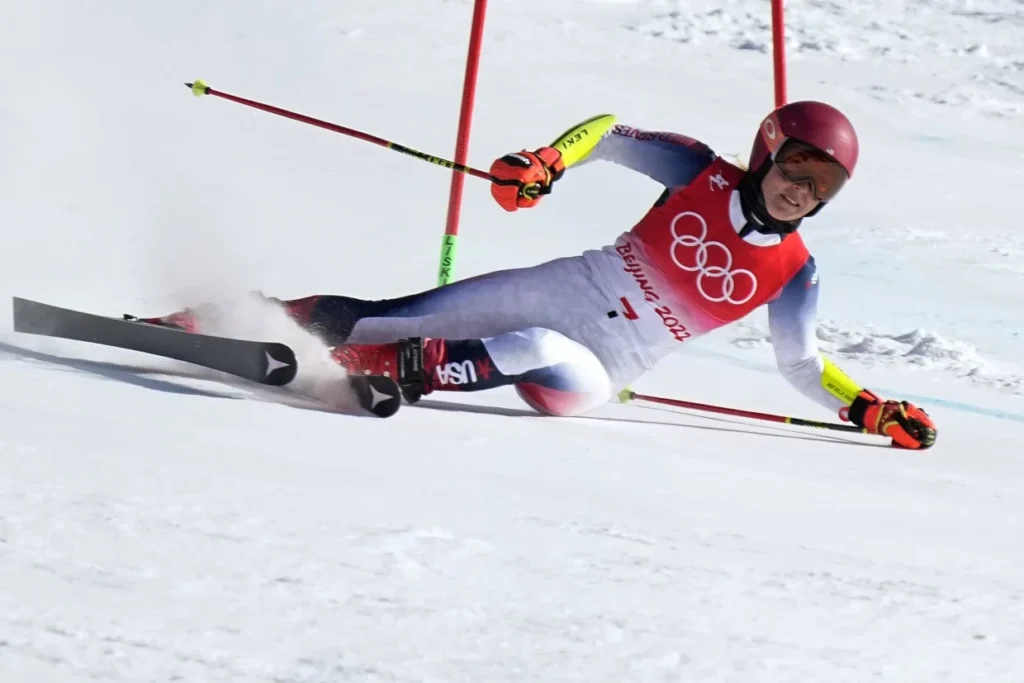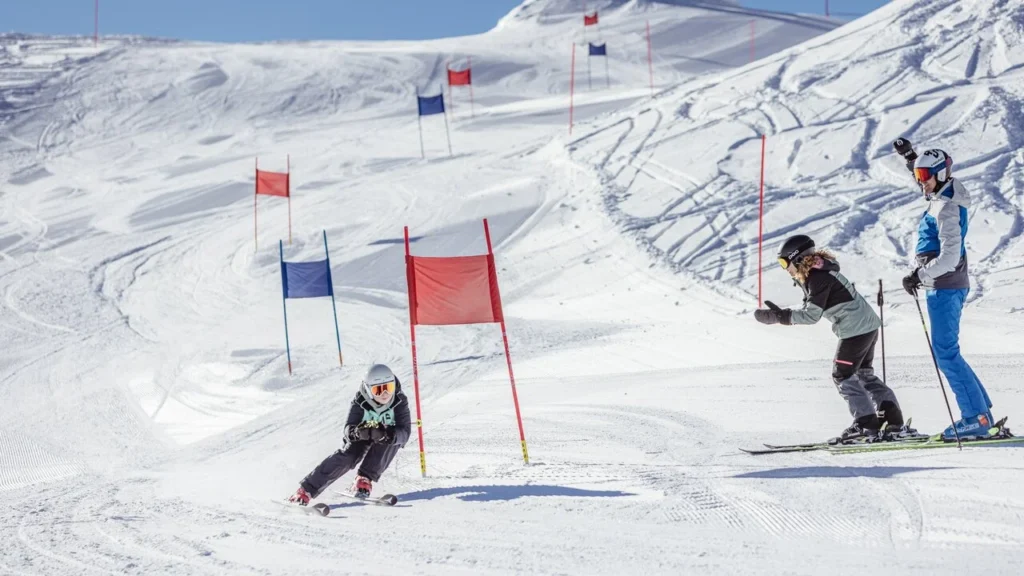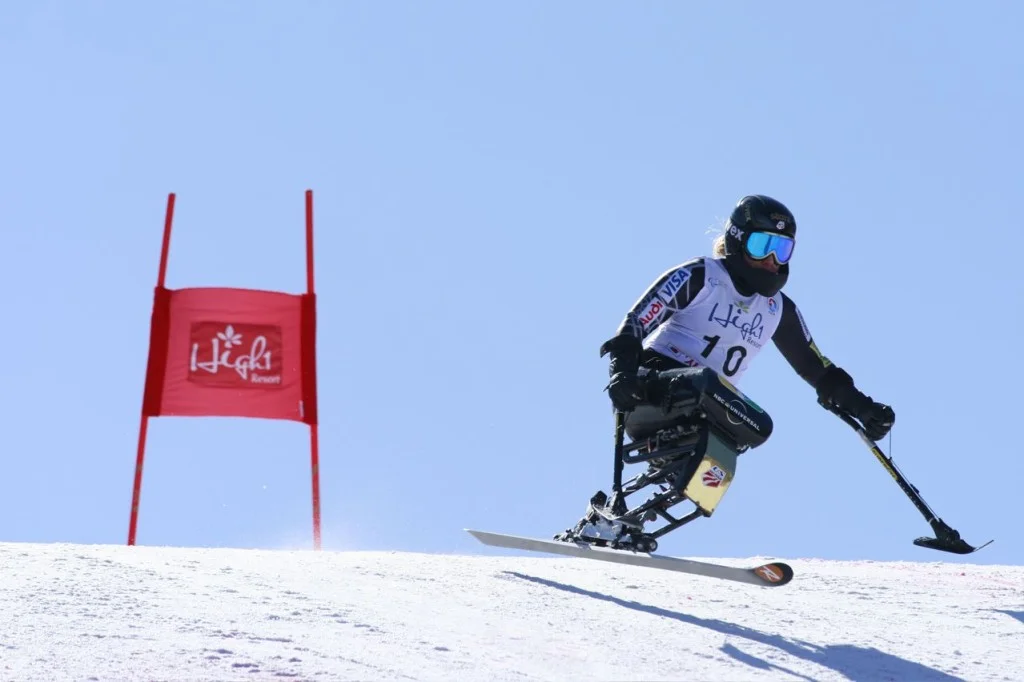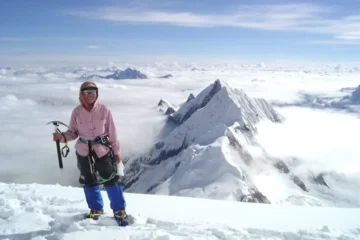Slalom skiing is renowned for its shortest courses and fastest turns in alpine skiing. In this thrilling event, competitors race against the clock, weaving through poles or ‘gates’ to achieve the best time. Let’s explore the fascinating history, rules, and equipment of slalom skiing.
The History of Slalom Skiing
In 1936, slalom skiing debuted at the Winter Olympics in Garmisch-Partenkirchen, Germany, as a component of alpine skiing. Initially, only a combined event was featured. However, slalom skiing became a standalone competition at the 1948 Winter Olympics in St. Moritz, Switzerland, and has remained a highlight of the Winter Games ever since.
Switzerland’s Edy Reinalter claimed the first-ever men’s slalom gold medal in 1948. He was followed by French skiers James Couttet, who won silver, and Henri Oreiller, who secured bronze. In the same year, Gretchen Fraser of the United States became the first woman to win a gold medal in slalom skiing, with Antoinette Meyer of Switzerland earning silver and Erika Mahringer of Austria taking bronze.
Austria holds the record as the most successful nation in men’s slalom at the Winter Olympics, boasting seven golds, five silvers, and six bronze medals. Meanwhile, the USA leads in women’s slalom with an impressive tally of four golds, one silver, and one bronze.

Slalom Skiing: Rules, Techniques, and Essential Equipment
Slalom skiing, one of the five alpine skiing events, is renowned for its rapid pace and sharp, technical turns. As a challenging and dynamic sport, it tests the agility, precision, and technique of competitors as they race through a zigzagging course. Here’s a comprehensive guide to the rules, equipment, and techniques of slalom skiing.
Rules of Slalom Skiing
Slalom skiing requires competitors to navigate a designated downhill course filled with “gates”—pairs of alternating red and blue plastic poles. Here are the key rules:
- Course Specifications: The vertical descent for men ranges from 180 to 220 meters, while for women, it spans 140 to 180 meters.
- Gate Dimensions: Each gate has a minimum width of 4 meters and a maximum of 6 meters, creating a challenging and technical layout.
- Dual Course Runs: Skiers must complete two courses, with eliminations occurring after the first run. The competitor with the lowest combined time from both courses emerges as the winner.
- Pole Interaction: Skiers often knock over poles while striving for the fastest path, showcasing their agility and precision.
Key Techniques in Slalom Skiing
Slalom skiing demands mastery of several technical skills. These fundamentals are essential for achieving speed and control:
- Outside Ski Dominance: The outside ski plays a pivotal role in maintaining balance and executing turns. Skiers must transition smoothly from one outside ski to the next during each turn, a skill honed through rigorous practice.
- Early Lower Leg Activation: This technique involves precise control of the ankle. By dorsiflexing and creating lateral movement early in the turn, skiers can gently edge their skis into the snow, ensuring optimal ski-snow interaction. This proactive tension in the ankle muscles enhances turn efficiency and control.
- Ski-Snow Contact: Maintaining consistent contact between the skis and the snow is critical. A well-executed turn lasts only 0.85 seconds in World Cup slalom events. Effective ski-snow contact tightens the arc of the turn, enabling skiers to take the shortest path.
- Pole Usage: Unlike in other skiing disciplines, slalom skiing incorporates active pole usage. Proper pole plants and touches enhance balance and control, allowing skiers to push their limits. However, reliance on poles must be balanced with precise ski control to avoid torso misalignment.
Essential Equipment for Slalom Skiing
Proper equipment is crucial for performance and safety in slalom skiing. Here’s what competitors need:
- Skis: Slalom skis are the shortest among alpine skiing events, with a minimum length of 165 cm for men and 155 cm for women. These skis allow for quick, tight turns.
- Bindings: These secure the skier’s boots to the skis, providing stability and control.
- Crash Helmet: Designed with soft ear protection and a chin guard, helmets shield skiers from impacts with gates.
- Goggles: Essential for clear vision and protection against snow and wind.
- Ski Suit: Typically skintight to minimize air resistance, ski suits enhance speed and agility.
- Shinpads: Protect skiers from potential injuries caused by gate impacts.
The Art of Efficiency in Slalom Skiing
Top slalom skiers, such as Mikaela Shiffrin, exemplify a seamless flow of movement built on solid fundamentals. Their techniques emphasize balance, efficiency, and a mastery of the basics. The combination of outside-ski dominance, early edge engagement, and effective pole usage creates a rhythm that minimizes drama while maximizing speed.
Why Slalom Skiing Captivates Audiences
Slalom skiing is an exhilarating demonstration of technique, speed, and talent. Its unique blend of technical precision and athletic prowess makes it one of the most exciting alpine events. Whether you’re an aspiring skier or an avid fan, understanding the intricacies of slalom skiing deepens your appreciation for this remarkable sport.
Mixed Team Parallel Slalom
The mixed team parallel slalom made its electrifying debut at the PyeongChang 2018 Winter Olympics. This exciting event captivated audiences worldwide as skiers competed head-to-head on two identical side-by-side courses. The dual format not only heightened the tension but also made it easy for spectators to immediately identify the winners and losers, creating moments of pure adrenaline, especially in the knockout stages.
How the Mixed Team Parallel Slalom Works
In each round, four skiers from one country – two men and two women – face off against a team from another country. Points are awarded for each race win, and the team with the most points advances. However, if the score is tied at 2-2, the team with the fastest combined time secures victory.
The competition progresses through a round of 16, quarter-finals, semi-finals, and ultimately, the final. This format keeps the action intense and unpredictable, leaving fans on the edge of their seats.
One intriguing aspect of this event is the psychological challenge for skiers. Can they remain focused on their own performance, or will the sight of an opponent inching ahead throw them off their game? This mental battle adds another layer of complexity to the already demanding sport.
Must-Know Insights About Alpine Skiing Events
Alpine skiing events are as much about strategy as they are about skill. Here are some fascinating aspects to watch for:
- Different ski lengths: Speed-focused skiers use longer skis for stability, while technical skiers prefer shorter skis for precision turns.
- Pre-race rituals: Some skiers place snow on the back of their necks to stay sharp and energized before their run.
- Timing boards: At the base of the slope, a timing board displays results. Skiers often glance at it mid-slide to gauge their standing, even before coming to a stop.

Why Slalom Skiing is Worth the Challenge
Slalom skiing combines technical mastery with exhilarating speed, making it a favorite among both skiers and fans. Whether you’re watching the mixed team parallel slalom or working on your own skills, this sport promises excitement at every turn. With the right guidance and a commitment to improvement, you’ll soon be carving through the snow with precision and confidence.
Explore more tips and take your skills to the next level by joining expert-led ski lessons or hitting the slopes with renewed determination. Embrace the challenge of slalom skiing and discover why it’s one of the most rewarding experiences in alpine sports.
Slalom Skiing: Mastering Big, Round Turns
When it comes to slalom skiing, many beginners assume that sharp, rapid turns are essential to maneuver between the gates. However, the reality is quite the opposite. The fluid, seamless movements of professional World Cup skiers stem from their ability to execute smooth, rounded turns. Tight turns often result in skidding and chatter, which not only disrupt your ski line but also cost you valuable time. Focusing on big, round turns ensures better control and a more efficient run through the slalom course.
Slalom Skiing: Maintain a Quiet Upper Body
A key aspect of slalom skiing is keeping your body steady and aligned as you pass through the gates. Instead of maneuvering around the gates, your body should move directly through them, producing the distinctive “thwack” sound as you clear or block the gate with your arm. Proper technique involves isolating arm movements from the rest of your body. Flailing arms or unnecessary upper-body movement can throw you off balance, disrupt your line, and slow you down. Keep your body centered and focused on your path for optimal performance.
Slalom Skiing: Choosing the Perfect Line
Your visual focus plays a pivotal role in effective slalom skiing. To maintain a fast and efficient line, your skis must pass through the gates as closely as possible without risking a hook—when one ski veers to the wrong side of the gate. A helpful technique is to focus your vision on the outside of the gate rather than the inside. This strategy encourages your skis to stay closer to the gate’s inside edge, allowing for a tighter and faster line through the course. Remember, a precise line not only improves your speed but also enhances your overall accuracy.
Slalom Skiing: Mastering Carving Techniques
Strong carving skills are non-negotiable for success in slalom skiing. Skidding or chattering on the slope can lead to missed gates, slower times, and a disrupted rhythm. Effective carving starts at the very beginning of each turn. Pay attention to how you arrange your body to do this. Absorb pressure at the end of each turn by flexing your hips and knees, and extend them as you initiate the next turn to press your skis firmly into the snow. This technique allows you to carve early and maintain a clean, efficient path through the gates.
Slalom Skiing: Practice and Persistence
As with any skill, practice is the cornerstone of improvement in slalom skiing. While understanding the techniques and strategies is important, consistent practice on the slopes is what truly drives progress. At Chill Factore, you have access to the slopes seven days a week, giving you the perfect opportunity to refine your slalom skiing skills. Book a private ski lesson with one of our experienced instructors to get personalized guidance and take your performance to the next level. Start your journey to mastering slalom skiing today by planning your next visit.
Understanding the Slalom Discipline
Slalom skiing is part of a broader spectrum of ski racing disciplines, each offering unique challenges. Comparable to the various strokes in swimming, skiing includes downhill, super-G, giant slalom (GS), and slalom events. Here’s how slalom stands out:
- Course Layout: Slalom courses consist of a series of gates made up of two rigid plastic poles alternating in red and blue. These gates are positioned no more than six meters apart, requiring racers to execute rapid, tight turns.
- Speed vs. Technique: Unlike downhill and super-G, where racers reach speeds exceeding 80 mph, slalom skiing prioritizes technical precision over velocity. Its tighter gate spacing demands faster reaction times and advanced agility, making it the most technical discipline in ski racing.
Tips for Better Slalom Skiing
- Practice Body Positioning: Maintain a low and compact stance with proper weight distribution to ensure your skis stay engaged with the snow.
- Focus on Line: Plan your turns in advance to maintain a smooth and efficient line through the gates.
- Enhance Agility: Incorporate agility drills and strength training to improve reaction times and balance.
- Work with a Coach: Personalized feedback can help identify and address bad habits before they become ingrained.
By addressing these common mistakes and refining your technique, you can significantly enhance your slalom skiing skills and performance on the course. Consistent practice, combined with a focus on fundamentals, will ensure steady improvement and help you excel in this demanding discipline.
Bad Habits in Slalom Skiing and How to Overcome Them
Slalom skiing is an exhilarating yet highly technical discipline that demands precision, agility, and quick reaction times. However, many racers develop bad habits that hinder their performance. Let’s explore these common pitfalls and how to correct them to improve your slalom skiing technique.
Overreaching
Overreaching is one of the most prevalent mistakes in slalom skiing. Racers often attempt to reach across their body’s centerline to block a gate, an instinctive move to protect themselves. Unfortunately, this habit creates a rotational cascade that disrupts balance and control:
- Impact on Technique: Overreaching causes the upper body to rotate excessively, which can lead to the hips and skis following suit. This rotation reduces the grip of the ski’s outside edge, causing it to skid and lose traction.
- Consequences: Skidding disrupts the skier’s line and momentum, pushing them into an area known as “No Man’s Land.” Repeating this mistake results in poor alignment with the fall line and often leads to the skier rotating out of the course altogether.
- Solution: Focus on maintaining a compact upper body position with proper angulation. Allow your legs and skis to do the work of navigating the gates while keeping your shoulders aligned with the fall line.
Chicken Wings
The term “chicken wings” describes a posture where racers, often young or inexperienced, extend their arms awkwardly to make gate contact. While this may seem like an attempt to assert control, it actually undermines performance:
- Impact on Technique: This motion causes racers to lose their intended line, forcing them to react to the course rather than ski it proactively.
- Solution: Train to keep your arms in a natural and relaxed position, ensuring they contribute to balance and stability rather than distraction. Practice drills that emphasize smooth gate transitions to build confidence and technique.
Overactive Hands (“Happy Hands”)
Overly active hand movements can disrupt a skier’s balance and rhythm:
- Impact on Technique: Each exaggerated hand motion requires a counter-movement to restore equilibrium, leading to a cycle of imbalance that hinders clean, precise turns.
- Solution: Aim for controlled and purposeful hand positioning. To cut down on pointless motions including stability and balance drills in your training.
Understanding the Basics of a Slalom Course
A traditional slalom course isn’t just a straight line from the top of the slope to the bottom. Instead, gates are arranged in a staggered pattern, requiring skiers to make quick, tight turns. This setup challenges racers to maintain speed while executing precise maneuvers.
If you’ve ever watched slalom skiing, you’ve likely noticed racers aggressively knocking gates aside as they speed through the course. While it’s not a requirement to hit the gates, doing so often leads to a faster line. By skiing as close to the gates as possible, racers minimize the distance traveled, shaving critical seconds off their time. In a sport where victories are decided by mere hundredths of a second, every advantage counts.

The Role of Equipment in Slalom Skiing
Slalom racers wear specialized gear to protect themselves from the hard plastic gates they encounter at high speeds. Shin guards, pole guards, and helmet visors shield racers from impact, allowing them to focus on speed and precision without worrying about injury. This protective equipment is essential in a discipline where success often requires pushing physical limits.
Types of Gates and Course Variations
No two slalom courses are identical. Course setters introduce variety to challenge racers, using both open and closed gates to alter the rhythm and difficulty.
- Open Gates: These gates run horizontally across the slope and are perpendicular to the fall line, requiring racers to make wide turns.
- Closed Gates: These gates are aligned vertically and parallel to the fall line, demanding tighter, quicker turns. Examples include:
- Hairpin Gates: A pair of closely spaced gates requiring rapid directional changes.
- Flush Gates: Two or more consecutive hairpin gates, often set straight down the fall line. While these sections can increase speed, they also demand precise control as racers transition back to open gates.
These variations ensure that slalom courses test not only a racer’s speed but also their adaptability and technical skills.
Race Preparation and Strategy
Unlike downhill racers, who are allowed practice runs, slalom skiers don’t have the luxury of running the course before competing. Instead, they are given a brief inspection period to memorize the layout and identify potential challenges.
You’ve probably seen racers at the starting gate visualizing their run with their eyes closed and hands mimicking ski motions. This mental rehearsal helps them plan their line and anticipate the transitions between gates. Precision and memory play crucial roles in their success.
The Thrill of Slalom Skiing
While slalom skiing may not reach the breakneck speeds of downhill racing, it’s equally thrilling. The combination of rapid turns, strategic gate navigation, and high-stakes competition makes it one of the most exciting disciplines in alpine skiing. Watching elite athletes tackle these courses offers a mesmerizing display of skill and athleticism.
When the Winter Olympics come around, you’ll now have a deeper appreciation for the art of slalom skiing. From understanding the nuances of course design to recognizing the intense preparation required, you’re equipped to enjoy the sport on a whole new level.
Conclusion
Slalom skiing is much more than just a race; it’s a test of skill, strategy, and determination. Each course brings unique challenges, and racers must adapt quickly to maintain their edge. With its blend of precision and speed, slalom skiing captivates both participants and spectators alike.
When the Winter Olympics come around, you’ll now have a deeper appreciation for the art of slalom skiing. From understanding the nuances of course design to recognizing the intense preparation required, you’re equipped to enjoy the sport on a whole new level.
Frequently Asked Questions (FAQs)
1. What is slalom skiing? Slalom skiing is a competitive alpine skiing discipline where racers navigate a downhill course marked by staggered gates, requiring quick and precise turns.
2. Why do slalom skiers hit the gates? Skiers hit the gates to take the shortest and fastest path through the course. This minimizes their distance traveled and helps reduce their overall time.
3. What equipment is essential for slalom skiing? Key equipment includes skis, poles, boots, and protective gear such as shin guards, pole guards, and helmets with visors to shield against impacts with the gates.
4. What are the types of gates used in slalom courses? The two main types are open gates, which require wide turns, and closed gates, such as hairpin and flush gates, which demand tighter, more rapid turns.
5. Do slalom racers get to practice on the course before competing? No, slalom racers do not get practice runs. They are allowed a brief inspection period to memorize the course and plan their strategy.
For Getting More Information Thezvideo.




